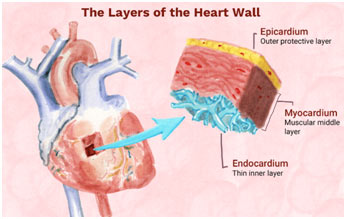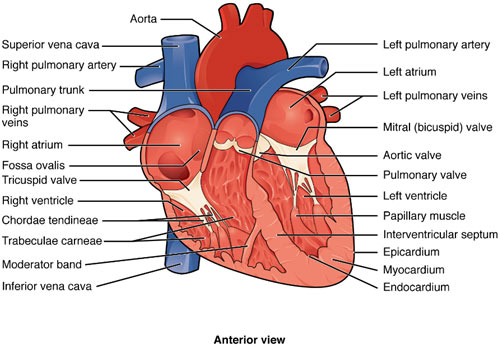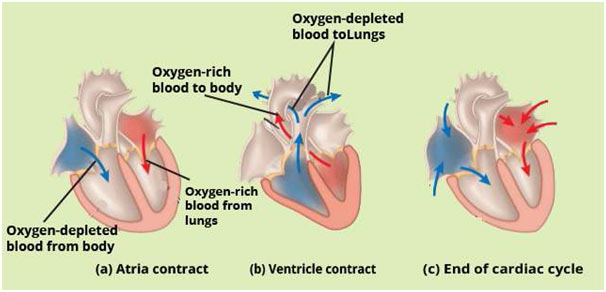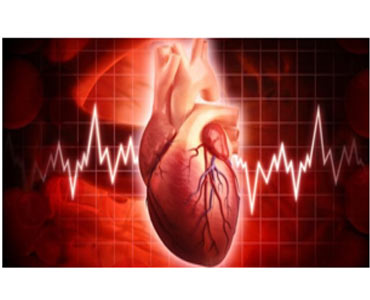The circulatory system of humans has 3 basic components.
- (A) Circulating fluid – the blood.
- (B) The pumping organ – the heart.
- (C) The blood vessels, arteries, capillaries, and veins.
In this article, we will discuss the pumping organ in human bodies – The Heart.
- 1) Pumping Organ- The Heart
- 2) Structure and Function
- 3) The Cardiac Cycle
- 4) Mechanism of Heart Excitation and Contraction
- 5) Electrocardiogram
- 6) Artificial pacemaker
- 7) Facts about Human Heart
- 8) FAQs about the Human Heart
- 9) Multiple Choice Questions (MCQs) about Human Heart:
- 10) You may also like to learn:
Pumping Organ- The Heart
The human heart is an organ that pumps blood throughout the body using the circulatory system, supplying oxygen and nutrients to the tissues and removing carbon dioxide and other wastes. The heart of humans lies in the chest cavity. The heart is enclosed in a double membranous sac – the pericardial cavity, which includes the pericardial fluid. Pericardium protects the heart, prevents it from overextension.
You may also like to read: Blood Circulatory System in Humans
Structure and Function

The wall of the heart is composed of three layers.
- (i) Epicardium
- (ii) Myocardium
- (iii) Endocardium
Myocardium of the heart is made up of a unique type of muscles, the heart muscles.
These muscles consist of myofibrils, and myofilaments of myosin and actin. Their structural plan resembles those in skeletal muscle fibres, and their mechanism of contraction is basically the same, except that they are branched cells, in which the succeeding cells are separated by junctions called intercalated discs. The heart contracts automatically with rhythmicity, under the control of the autonomic nervous system of the body.
There are 4 chambers of the heart: two upper thin-walled atria, and 2 lower thick-walled ventricles. The human heart functions as a double pump and is accountable for lung and systemic flow. The total separation of deoxygenated blood (Right side) and oxygenated blood (left side), in the heart, is kept. The right atrium receives deoxygenated blood via venae cavae from the body. The blood is passed on to the right ventricle through the tricuspid valve (called so because it has 3 flaps).

These flaps are connected with fibrous cables called chordae tendineae, to the papillary muscles which are extensions of the wall of the right ventricle. When the right ventricle contracts, the blood is passed to the pulmonary trunk, which carries blood by means of left and right pulmonary arteries, to the lungs.
At the base of the pulmonary trunk, semilunar valves exist. After oxygenation in the lungs, the blood is brought by pulmonary veins to the left atrium, which passes this blood by means of a bicuspid valve (called so because it has two flaps) to the left ventricle. The flaps of the bicuspid valve are similarly attached through chordae tendineae, to the papillary muscles of the wall of the left ventricle. When the left ventricle contracts, it presses the blood through the aorta to all parts of the body (other than lungs).
At the base of the aorta semilunar valves are also present. The valves of the heart control the direction of the flow of blood. The wall of the left ventricle is thicker (about 3 times) than that of the right ventricle. At the base of the aorta, the first pair of arteries, the coronary arteries, arise and supply blood to the heart.
The aorta forms an arch, and prior to descending down offers 3 branches providing blood to the head, arms and shoulders. The aorta descends down in the chest cavity. It gives numerous little branches to the chest wall and then gives it to the stomach. Here it offers branches, which supply blood to different parts of the alimentary canal, kidneys, and the lower abdominal area.
The aorta Bifurcates into iliac arteries, each of which results in supply blood to each leg. The blood from the upper part of the body is collected by different veins, which join to form superior vena cava; which passes its blood to the right atrium.
Two Iliac veins are formed by veins which gather blood from legs and join to from the inferior vena cava. It gets renal vein from each kidney; and hepatic vein from the liver, before it goes into the right atrium. The liver receives a hepatic portal vein which is formed by numerous veins gathering deoxygenated blood with absorbed food from different parts of the alimentary canal.
The Cardiac Cycle
It is the sequence of events which happen during the completion of one heartbeat.
Heartbeat involves 3 unique phases which are as follows:
Relaxation phase – diastole
The deoxygenated blood goes into the right atrium through the vena cava, and oxygenated blood enters the left atrium through pulmonary veins. The walls of the atria and that of ventricles are relaxed. As the atria are filled with blood, they become distended and have more pressure than the ventricles. This relaxed period of heart chambers is called diastole.
Atria Contract – atrial systole
The muscles of atria simultaneously contract, when the atria are filled and distended with blood, this is called atrial systole. The blood goes through the tricuspid and bicuspid valves, into the two ventricles which are relaxed.
Ventricles contract – ventricular systole
When the ventricles get blood from atria, both ventricles contract at the same time, and the blood is pumped to pulmonary arteries and aorta. The tricuspid and bicuspid valves close, and ‘lubb’ sound is made. Ventricular systole ends, and ventricles relax at the same time semilunar valves at the base of the lung artery and aorta close simultaneously, and ‘dubb’ noise is made. (Lubb, dubb can be heard with the help of a stethoscope).
One complete heartbeat includes one systole and one diastole and lasts for about 0.8 seconds. In one’s life, the heart contracts about 2.5 to 3 billion times, without stopping.

Mechanism of Heart Excitation and Contraction
The heartbeat cycle starts when the Sino-atrial node (Pacemaker) at the upper end of the right atrium sends electrical impulses to the atrial muscles and triggering both atria to contract. The Sino-atrial node consists of a small number of diffusely oriented cardiac fibres, possessing few myofibrils; and a couple of nerve endings from the autonomic nerve system.
Impulses from the node travel to the musculature of the atrium and to an atrioventricular node. From it, an atrioventricular bundle of muscle fibres propagates the regulative impulses through excitable fibres in the interventricular septum, to the myocardium of the ventricles. There is a hold-up of around 0.15 second in conductance from the S-A node to A-V node, permitting atrial systole to be finished prior to ventricular systole begins.
Electrocardiogram
As the cardiac impulse passes through the heart, electrical currents spread out into the tissues surrounding the heart, and a small percentage of these spread all the way on the surface of the body. If electrodes are put on the skin on opposite sides of the heart, electrical potentials produced by these currents can be taped.
This recording is called electrocardiogram which is taken by an electrocardiograph (E.C.G.) device. It helps to diagnose the irregularities in the rhythmicity and conduction system of the heart which might be corrected by the use of an artificial pacemaker.
Artificial pacemaker
The pacemaker is accountable for starting the impulses which activate the heartbeat rate. If there is some block in the flow of the electrical impulses, or if the impulses initiated by S.A. node are weak; it may cause the death of the individual. So, an artificial pacemaker, which is battery operated producing electrical stimulus is utilized. For example, if A-V pathway is blocked, the electrodes of the artificial pacemaker are connected to the ventricle.
Then this pacemaker supplies continued rhythmic impulses that take control of the control of the ventricles.
Facts about Human Heart
- A human heart is approximately the size of a large fist.
- The heart weighs between about 280 to 340 grams in males and 230 to 280 grams in females.
- The heart beats about 100,000 times daily (about 3 billion beats in a lifetime).
- An adult heart beats about 60 to 80 times per minute.
- Newborns’ hearts beat about 70 to 190 beats per minute which is faster than the adult heart.
- The heart pumps about 5.7 litres of blood throughout the body.
FAQs about the Human Heart
1. What are the three basic components of the human circulatory system?
- The three fundamental components are circulating fluid (blood), the heart (pumping organ), and blood vessels (arteries, capillaries, and veins).
2. Where is the human heart located?
- The human heart is located in the chest cavity and is enclosed by a double membranous sac called the pericardium.
3. What are the layers of the heart wall, and what is the function of the myocardium?
- The heart wall has three layers: epicardium, myocardium, and endocardium. The myocardium, made of special heart muscles, is responsible for the heart’s rhythmic contractions.
4. How many chambers does the human heart have, and what is their function?
- The heart has four chambers: two atria (upper) and two ventricles (lower). It functions as a double pump, separating deoxygenated blood (right side) and oxygenated blood (left side).
5. Explain the cardiac cycle.
- The cardiac cycle is the sequence of events during one heartbeat, involving diastole (relaxation), atrial systole (atria contraction), and ventricular systole (ventricles contraction).
6. What is an electrocardiogram (E.C.G.) and what does it help diagnose?
- An electrocardiogram is a recording of the heart’s electrical activity. It helps diagnose irregularities in the rhythmicity and conduction system of the heart.
7. What is an artificial pacemaker, and when is it used?
- An artificial pacemaker is a battery-operated device that produces electrical stimuli to initiate heartbeats. It is used when there is a block in the flow of electrical impulses or if impulses are weak.
8. How many times does the heart beat in a lifetime?
- The heart beats about 100,000 times daily, translating to approximately 3 billion beats in a lifetime.
9. What is the size and weight of a human heart?
- The heart is approximately the size of a large fist. It weighs between 280 to 340 grams in males and 230 to 280 grams in females.
10. How much blood does the heart pump throughout the body?
- The heart pumps about 5.7 liters of blood throughout the body daily.
11. What is the average heartbeat per minute for adults and newborns?
- Adults have an average heartbeat of 60 to 80 times per minute, while newborns’ hearts beat about 70 to 190 beats per minute.
Multiple Choice Questions (MCQs) about Human Heart:
1. What are the three basic components of the human circulatory system?
- A) Heart, Lungs, Kidneys
- B) Blood, Lungs, Stomach
- C) Blood, Heart, Blood Vessels
- D) Heart, Brain, Liver
Answer: C) Blood, Heart, Blood Vessels
2. Where is the human heart located?
- A) Abdomen
- B) Head
- C) Chest Cavity
- D) Pelvis
Answer: C) Chest Cavity
3. What is the purpose of the pericardium?
- A) Filters Blood
- B) Protects the Liver
- C) Prevents Overextension of the Heart
- D) Aids Digestion
Answer: C) Prevents Overextension of the Heart
4. Which layer of the heart is responsible for rhythmic contractions?
- A) Epicardium
- B) Myocardium
- C) Endocardium
- D) Pericardium
Answer: B) Myocardium
5. How many chambers does the human heart have?
- A) 2
- B) 3
- C) 4
- D) 5
Answer: C) 4
6. What is the function of the tricuspid valve?
- A) Prevents Backflow to Lungs
- B) Controls Blood Flow to the Brain
- C) Separates Deoxygenated and Oxygenated Blood
- D) Aids in Digestion
Answer: C) Separates Deoxygenated and Oxygenated Blood
7. During which phase of the cardiac cycle do the ventricles contract?
- A) Diastole
- B) Atrial Systole
- C) Ventricular Systole
- D) Lubb
Answer: C) Ventricular Systole
8. What is the duration of one complete heartbeat in the cardiac cycle?
- A) 1 second
- B) 0.5 seconds
- C) 0.8 seconds
- D) 2 seconds
Answer: C) 0.8 seconds
9. What initiates the heartbeat cycle in the heart?
- A) Coronary Arteries
- B) Sino-atrial Node (Pacemaker)
- C) Atrioventricular Node
- D) Myofibrils
Answer: B) Sino-atrial Node (Pacemaker)
10. What does an electrocardiogram (E.C.G.) record?
- A) Blood Pressure
- B) Heart Sounds
- C) Electrical Activity of the Heart
- D) Oxygen Levels in Blood
Answer: C) Electrical Activity of the Heart
11. When is an artificial pacemaker used?
- A) To Enhance Digestion
- B) To Initiate Heartbeat Impulses
- C) To Regulate Blood Flow to Lungs
- D) To Improve Kidney Function
Answer: B) To Initiate Heartbeat Impulses
12. How many times does the adult heart beat per minute on average?
- A) 40 to 60
- B) 80 to 100
- C) 120 to 140
- D) 160 to 180
Answer: B) 80 to 100
13. What is the approximate size of a human heart?
- A) Small Fist
- B) Large Fist
- C) Football
- D) Tennis Ball
Answer: B) Large Fist
14. How much does the heart weigh in males on average?
- A) 150 to 200 grams
- B) 230 to 280 grams
- C) 340 to 400 grams
- D) 500 to 550 grams
Answer: C) 340 to 400 grams
15. How many liters of blood does the heart pump throughout the body daily?
- A) 3.5 liters
- B) 5.7 liters
- C) 7.2 liters
- D) 9.5 liters
Answer: B) 5.7 liters
16. What is the heartbeat range for newborns?
- A) 30 to 50 beats per minute
- B) 50 to 90 beats per minute
- C) 70 to 120 beats per minute
- D) 100 to 150 beats per minute
Answer: C) 70 to 120 beats per minute
17. How many times does the heart contract in one’s lifetime approximately?
- A) 1 million times
- B) 2.5 to 3 billion times
- C) 5 billion times
- D) 10 billion times
Answer: B) 2.5 to 3 billion times
Summary
This guide tells us lots about the heart in simple terms. It starts by talking about the three things in our bodies that work together to move blood around: blood, heart, and blood vessels. The heart is like a pump in our chest, kept safe by a special covering.
We learn about the heart’s layers (like the outside, middle, and inside), with special muscles that help it pump automatically. The heart has four rooms, and it makes sure the dirty blood and clean blood don’t mix by using special doors.
The guide explains how the heart beats in a cycle, with times when it squeezes and relaxes. It also talks about how the heart gets its signal to beat and how doctors can check it with a special heart recording.
Sometimes, people need a little help with their heart, like a tiny machine (pacemaker) with batteries. This machine gives a gentle push to the heart when it needs help to keep beating regularly.
The guide ends with some cool facts about the heart’s size, how much it weighs, and how many times it beats every day. It even tells us that babies’ hearts beat faster than grown-ups!

